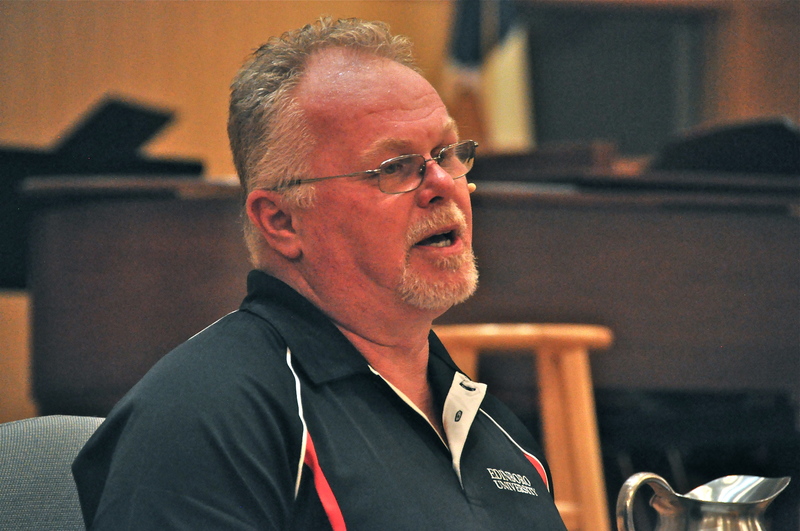Kirk Bloodsworth can still hear the sound of the 400-pound prison cell door closing on his life. Charged with the brutal rape and murder of a 9-year-old girl, he was convicted and sentenced to die in Maryland's gas chamber.
Bloodsworth spent nearly nine years in prison – two of those years on death row – for a crime he didn't commit. It was a crime that shocked the Baltimore, Md., area, dominating the news during the summer of 1984.
Overnight, Bloodsworth went from an anonymous, hard-working Cambridge, Md., waterman to a hated man fingered by five witnesses for the girl's murder.
He's also the first death-row inmate in the United States to be exonerated post-conviction by DNA testing. Although commonplace now, at the time of his trial, advanced DNA testing was not a common investigative technique. A tiny semen spot left by a depraved criminal saved Bloodsworth's life.
Bloodsworth told his dramatic story to members of Epworth United Methodist Church May 4 as an outreach program hosted by Epworth's Social Justice Pathway. The United Methodist Church went on record to oppose the death penalty at its 1954 General Conference and has upheld that stand ever since.
A horrific crime against a young girl
Dawn Hamilton's body was found in a wooded area. She had been violated with a stick, her head was crushed with a rock and her throat had been stepped on. “And that's the edited version of what happened to her,” Bloodsworth said. Her real killer would not be brought to justice for another decade.
Bloodsworth said he was at least three miles from the wooded area around Becky's Pond in Rosedale, Md., July 25, 1984, when young Dawn was killed. “She was playing hide and seek with friends and couldn't find them. She ran across two young boys who wouldn't help her, and she ran into a man who spoke up and said he would help her find her friends. She never came back home,” he said. Her body was found that same day; her underpants were hanging from a nearby tree.
|
BY THE NUMBERS 2.3 million: People in prisons 3,000: People on death row 1,300: Number of executions since 1976 289: Post-conviction DNA exonerations 17: People exonerated through DNA who served time on death row 16: Number of executions in Delaware since 1976 13.5: Average years served by exonerees Source: The Innocence Project |
Then came a perfect storm of mistaken identity and a prosecution team bent on a quick conviction that overcame the 24-year-old Bloodsworth before he had time to react. “The trial was only two weeks, and one witness after another pointed to me,” he said. “The gavel came down on me – death and double life sentences,” he said.
Something terrible is about to happen
In 1984, Bloodsworth was recently married and had just been discharged from the U.S. Marine Corps. He had taken up his father's profession, making a living on the waters and tributaries of the Chesapeake Bay. “But my wife was not ready for that lifestyle of me working 16 hours a day, and she moved back to Essex,” he said.
His marriage was on the rocks, but Bloodsworth said he was determined to give it one more shot as he hitchhiked to Essex near Baltimore on July 4 to be with his wife and find a new job. It was a decision he would regret for many years to come.
Bloodsworth left the Baltimore area about the time of the murder; after visiting his wife he returned home to Cambridge. “There was a knock at the door at 2:45 a.m.; it was the Baltimore County Police with a warrant for my arrest for first-degree murder. It was the last time I was to see my home for 8 years, 10 months and 19 days,” he said.
He was arrested on a Thursday and faced a lineup on Monday. “Police had already said we arrested a suspect and his name is Kirk Bloodsworth,” he said. “One of the witnesses said he recognized me from TV. The two little boys did not identify me in the lineup, but their parents called back two weeks later and said the boys make a mistake.”
He was connected to the crime by a neighbor, who called police and said Bloodsworth looked like a composite sketch police had released. Five people, including the two young boys, identified Bloodsworth as the man they saw with the victim or near the crime scene.
Bloodsworth said he didn't come close to matching the description provided by witnesses who saw a man that day in the wooded area near Hamilton's home. That description was for a skinny man who was 6 feet, 5 inches tall with curly blond hair and a bushy mustache. Bloodsworth was 6 feet tall with red hair and glasses and was missing a tooth back then.
As it turned out, the real killer was 5 feet, 6 inches tall and weighed 160 pounds.
Bloodsworth said there was not one shred of physical evidence linking him to the crime, but comments he made were twisted around to make him appear guilty.
A statement he made to friends and relatives in Cambridge would also haunt him. When he returned to Cambridge after spending a few weeks in the Baltimore area, he told others he came home because he had done something terrible.
That “something terrible” was forgetting to get his wife the taco salad she wanted. “It's true that everything you say can and will be used against you,” Bloodsworth said.
An inmate locked away
Bloodsworth was sent to the Maryland Penitentiary in 1985, one of the most notorious prisons in the country during the 1980s. “When I came in I could hear the cat calls from the other prisoners. They said they knew what I did, and they were going to do the same to me over and over. I was one of the most hated men there,” he said.
His new home was three steps long and as wide as his outstretched arms.
He talks about filling his ears with paper to keep the cockroaches out and flooding the cell's floor to keep cool in the summer. He saw an inmate get hit in the head with a sock full of batteries and another get stabbed over a snack cake. One of his best friends in prison stabbed himself in the eyes with pencils. Asked how he could survive under such deplorable conditions, Bloodsworth said, “I'm a Marine, so I could take a lot of stuff. It was like war. I did the best I could.”
“What I do right now – talking to people – helps me, and the more I talk, the better I feel,” he added.
Religion had always been an important part of his life, and he converted to Catholicism while in prison.
A second chance at life
Bloodsworth had a second chance in the courtroom in 1987 when he was granted another trial on an appeal. This time, the judge still found him guilty but removed the death sentence giving him three life terms.
After his second trial, Bloodsworth started a seven-year stint working in the prison library. “I read everything I could get my hands on,” he said.
One book he read changed his life. It was about new, advanced DNA fingerprinting used to find a criminal in a town in England. “If the test could be used to convict, why couldn't it be used to free someone?” he asked himself.
In April 1989, he wrote a letter to Judge James Smith requesting a DNA test. Three years would go by from the time he wrote the first letter until a lawyer would step up to assist him. Attorney Robert Morin responded to a phone call from Bloodsworth and agreed to represent him pro bono. It was Morin who was able to push hard enough to get the test done.
But first, he had to locate the evidence, which was not in the Towson County Courthouse evidence locker where it should have been. Ultimately, it was found in a closet, Bloodsworth said.
In April 1993, a California lab found a spot of semen on Hamilton's underwear, and it didn't match Bloodsworth's DNA. Two months later an FBI lab confirmed the test, exonerating Bloodsworth of the crime.
The state dropped the case, and at 8:45 a.m. on June 28, 1993, he stepped out of prison a free man. This time he rode away in a limousine stocked with food and drink. He also received a $300,000 award from the state, most of which went to legal fees.
He was granted a full pardon by Gov. William Donald Schaefer in 1994.
Since his release from prison, he has testified before Congress, had a book written about his ordeal and appeared on several national TV shows including the former Oprah and Larry King Live shows. The book “Bloodsworth: The True Story of the First Death Row Inmate Exonerated by DNA” details his story.
Dawn gets her justice
When he read that Baltimore County Assistant State's Attorney Ann Brobst was not convinced of his innocence, he began a campaign to find the child's killer. In an ironic twist, it turned out the killer, Kimberly Shay Ruffner, was in the Maryland Penitentiary the same time as Bloodsworth was there. Ruffner had been sentenced to 45 years for the rape of an Essex woman. It wasn't until 2003 that a DNA match was confirmed linking Ruffer to the murder of Dawn Hamilton.
“He pleaded guilty saying he was high on drugs and was given a life sentence; Dawn finally had justice,” he said.
Although Bloodsworth didn't talk about it at Epworth Church, his life out of prison has been filled with pitfalls. An internet search of the many stories written about him reveals the difficulties he has suffered since his release from prison nearly 20 years ago. Bouts with drinking and depression, failed relationships and a succession of jobs greeted him the first few years from behind prison walls. He said it was hard to shake the “stigma” of the horrific crime hanging over him. He eventually returned to the life of a waterman where he was able to find solace.
Bloodsworth now lives in the Washington, D.C., area where he has become a spokesman for the Witness to Innocence program as an advocate against the death penalty. He has also been an ardent supporter of the Innocence Protection Act since its passage by Congress in February 2000. The act established the Kirk Bloodsworth Post-Conviction DNA Testing Program, a program that helps states defray the costs of post-conviction DNA testing. Bloodsworth said five inmates have taken advantage of grants to get testing.
Currently, there are 2.3 million inmates in U.S. prisons and 3,000 serving time on death row. Bloodsworth said of the nearly 150 exonerated death row inmates, 17 were released due to DNA testing.
The Delaware Citizens Opposed to the Death Penalty and The Repeal Delaware Project sent representatives to the program at Epworth.
For more information on the Witness to Innocence program, go to www.witnesstoinnocence.org.




















































